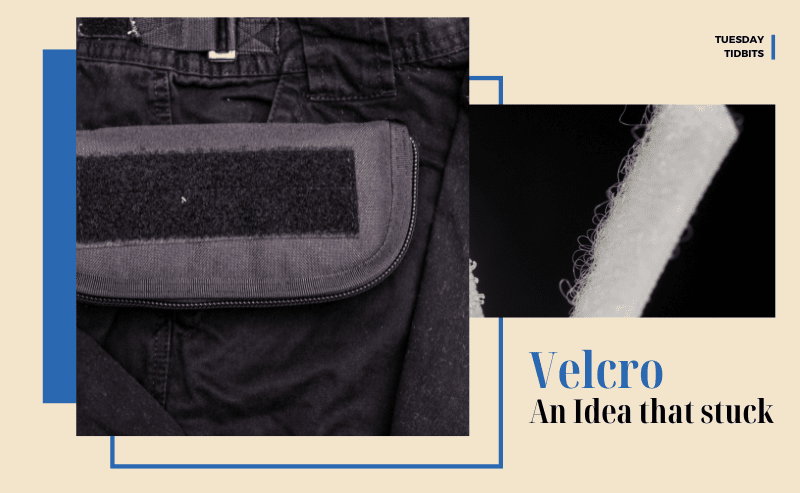Zippers, buttons, glue, staples, stitching. Prior to 1955, those were the main ways in which things were fastened together. But inventor George de Mestral’s 1941 discovery led to an easier and often more effective way of conjoining two things: VELCRO. While we’ve all used the substance and it’s a common part of things we use every day, it was an invention that was a long time in the making.
VELCRO is actually not a product but rather a company name. Officially known as Velcro IP Holdings LLC and trading as Velcro Companies, VELCRO is a British privately-held company — the same company de Mestral founded in the 1950s. From the French words “velour” (velvet) and “crochet” (hook), de Mestral created the iconic VELCRO® trademark to identify his brand of hook-and-loop fastener.
From Burdock Burs to VELCRO
The idea for VELCRO’s unique fastening system started in 1941, when de Mestral was on a hunting trip in the Swiss Alps and noticed that both his pants and his Irish Pointer’s hair were covered in the cockleburs from a burdock plant. Where many might have brushed them off in irritation, de Mestral decided to study the burs under a microscope, more out of curiosity than out of any sensing of a new business opportunity.
What de Mestral saw were thousands of tiny hooks that efficiently bound themselves to nearly any fabric (or dog hair) that passed by. This inspired de Mestral’s ORIGINAL THINKING™ for hook-and-loop fasteners.
De Mestral realized that if he could create a synthetic form of this hook-and-loop phenomenon, it would allow for a new kind of fastener. His idea was to take the hooks he had seen in the burs and combine them with simple loops of fabric. The tiny hooks would catch in the loops, and things would just come together.
But it was far easier said than done. The first six European fabric companies de Mestral approached were highly skeptical of the idea and believed it couldn’t be done. Mass-manufacturing the loops was easy enough, but the tiny hooks were more difficult — they needed to be both flexible enough to separate from the loops when pressure was applied, yet firm enough to otherwise keep things together. But de Mestral eventually found a manufacturer in Lyon, France, that was combining relatively tough nylon with cotton — a fabric with the ability to hold its shape. And that was exactly what he was looking for. Using the fabric, de Mestral was able to create, by hand, the same small microscopic hooks he’d seen on burs and attach them to a separate piece of cloth with tiny loops.
De Mestral eventually took out a $150,000 loan to work on his project and, together with Alfred Gonet, Andre-Louis Burnier and Jean Michaud, subsequently formed a company — Velcro S.A. in Switzerland. You could say that the name stuck right along with his fastening invention.
In 1951, he filed a Swiss patent application for his hook-and-loop fastener invention. This first patent was issued on March 16, 1954. Additional patents were issued in Germany, Great Britain, Sweden, Italy, Holland, Belgium, France and Canada. In 1958, the VELCRO® trademark was registered in the U.S.
But while de Mestral had found his material and proven that it would indeed work, the problem was that he could only make the hooks by hand. Mass manufacturing remained beyond his grasp and he started running out of money. After much experimentation, de Mestral finally hit on using a modified version of something like a barber’s clippers. With the ability to keep the angle of the cut precise, he could finally build out a loom that would allow him to mass-produce his hook-and-loop fasteners — nearly 20 years after his initial brainstorm. The fastener consisted of two components: a lineal fabric strip with tiny hooks that could “mate” with another fabric strip with smaller loops, attaching temporarily until pulled apart. It was initially made of cotton but was eventually constructed with nylon and polyester.
But for all that VELCRO is an indispensable part of modern life, de Mestral’s fastener system was not an instant hit when it came to market in the early 1960s. Clothing manufacturers shied away from it, and it seemed like de Mestral’s invention, like so many others, would simply be relegated to the status of something interesting but ultimately useless.
But then NASA changed all that.
VELCRO Lifts Off, Thanks to NASA
Looking for a way to keep objects attached to walls while floating in orbit, NASA discovered the VELCRO Brand fastener system. Suddenly, de Mestral’s invention wasn’t an oddity — it was space age. And so, it didn’t take long for it to begin showing up in apparel in the mid-1960s. By 1968, VELCRO Brand hook-and-loop solutions began to replace shoelaces, buttons, and press studs on shoes, gloves and jackets. And in 1992, VELCRO Brand HTH plastic hook tabs were first used on Huggies® Supreme diapers.
Fire-retardant hook-and-loop tapes were introduced in 1979 for applications where flames are a possibility, such as metalworking plants or plenum space. And in 1980, the VELCRO Brand HI-GARDE® high temperature stainless steel fastener system was developed for NASA’s Space Shuttle program. High-temperature environments such as oil and gas, firefighting and chemical plants thus gained the benefit of hook-and-loop fasteners that align with fire-retardant standards.
VELCRO in the Military
In 1984, VELCRO Companies started supplying MIL-SPEC hook and loop tapes to the US Military and many other governments, worldwide. And in 1988, VELCRO Brand Mold-in molded hook products emerged as an alternative to wires and hog rings in automotive seating to attach the seat fabric.
VELCRO USA Inc. received its first ISO 9001 registration in 1995, and in 1997, VELCRO USA Inc. and VELCRO Canada Inc. obtained QS 9000, the first industry-wide quality standard for automotive.
De Mestral passed away in 1990 in Commugny, the same Swiss village where he had his breakthrough. He had long since sold the rights to his creation to the VELCRO Companies. But de Mestral will always be linked to VELCRO Companies’ hook-and-loop fasteners, which started out as an annoyance on his pant leg, but made it all the way to the moon.









Leave A Comment